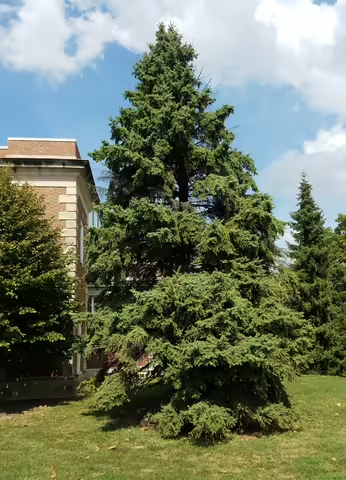URBANA, Ill. – They are beautiful, tempting, and frequently for sale in Illinois garden centers, but many nonnative trees are less than ideal for land of Lincoln landscapes.
“Some fall onto my ‘do not plant’ list,” says Ryan Pankau, a University of Illinois Extension horticulture educator. “Many such ornamental plants make my list due to their invasive habit, but some are on there for generally poor performance as urban trees.”
One such tree, the Colorado blue spruce, Picea pungens, is native to the Rocky Mountains of Colorado and several surrounding western states. Adapted to the cool, dry climate of the Rockies, it does well in more sandy and well drained soils; however, it is commonly sold in Illinois gardening centers.
“Despite its unique and beautiful, blue-green foliage, Colorado blue spruce tops my list of trees not to plant in Illinois,” Pankau says. “When planted in the Midwest, blue spruce suffers from our hot humid summers and often poorly drained soils.”
Unless the blue spruce is planted in near optimal conditions for Illinois, the stresses of the local climate and soils add up over time, reducing the plant’s heath and vigor. As these trees mature, it is a sure bet they will suffer from a variety of common diseases, issues and problems. For information about common issues with spruce trees, visit go.illinois.edu/SpruceProblems.
“Callery pear, Pyrus calleryana, is widely planted for its ornamental value, with more than 20 cultivars available at my last count,” says Pankau. “The plant certainly has appeal, with nearly a month or more of flower display each year. But it definitely has its problems.”
Native to East Asia, Callery pear has relatively few disease or insect issues in the U.S., but it is highly susceptible to storm damage.
“Callery pear’s compact and pyramidal habit can be attributed to a propensity for narrow branch angles with weak attachment,” says Pankau. “When it’s mature, the ultimate fate for many of these trees is to peel apart in a wind or ice storm, leaving an irregular and unattractive canopy.”
On a more serious note, this species has shown to be increasingly invasive. While most cultivars are sterile, cross pollination between the many commonly planted varieties has created fertile fruits. As birds eat and disseminate these fruits, new pear trees pop up all over the place.
“From fence rows to highway right of ways, to edges of yards or local natural areas, you can see Callery pears on nearly any drive around central Illinois when it is in flower,” Pankau says.
It is one of the only woody species to have white, abundant flowers during its bloom time in early spring, making it easily identifiable.
“Callery pear is yet another plant that I would argue has great ornamental value, like the blue spruce,” Pankau says. “However, vulnerability to storm damage can limit its longevity in the landscape and when you combine that with the threat to natural areas it poses as an invasive species, it’s just a tree that we all need to stop planting.”
SOURCE: Ryan Pankau, Horticulture Educator, Illinois Extension
ABOUT EXTENSION: Illinois Extension leads public outreach for the University of Illinois by translating research into action plans that allow Illinois families, businesses, and communities to solve problems, make informed decisions, and adapt to changes and opportunities.
PHOTO ACCESS: The photo in this article is available to download for media use.
